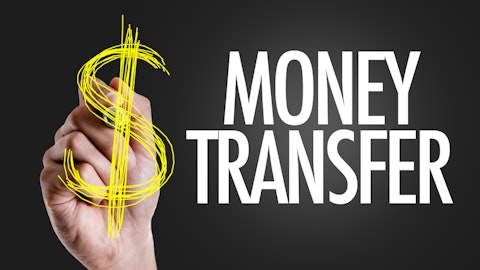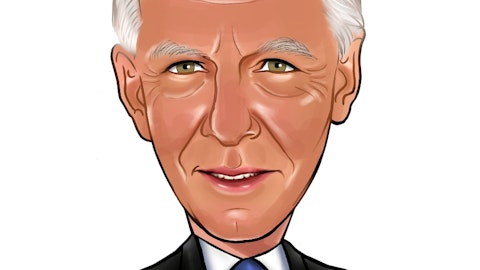Wedgewood Partners recently released its Q3 2020 Investor Letter, a copy of which you can download here. The Fund returned 10.77% for the third quarter of 2020. Meanwhile, the benchmark S&P 500 Index and the Russell 1000 Value Index gained 8.93% and 5.59%, respectively. You should check out Wedgewood Partners’ top 5 stock picks for investors to buy right now, which could be the biggest winners of this year.
In the said letter, Wedgewood Partners spoke about Visa Inc. (NYSE:V) and Paypal Holdings Inc. (NASDAQ:PYPL) stocks. Both Visa Inc. (NYSE:V) and Paypal Holdings Inc. (NASDAQ:PYPL) are fintech stocks. Year-to-date, Visa Inc. (NYSE:V) stock gained 4.8% and on October 19th it had a closing price of $196.97. Year-to-date, Paypal Holdings Inc. (NASDAQ:PYPL) stock gained 85% and on October 19th it had a closing price of $200.06. Here is what Wedgewood Partners said:
“We believe this is an opportune time to update clients about our sizable payments industry exposure, as the coronavirus pandemic has resulted in meaningful positive developments for the industry. With no insensitivity intended toward people whose health and livelihoods have been harmed, significant portions of the market have been trading like a pandemic somehow has been a positive thing for their businesses; in the case of these two companies, this is very much true.
We long have discussed the substantial, nearly open-ended global opportunities for the digital payments industry as multiple long-term secular trends have all favored a shift toward digital, rather than cash, payment: everything from the rise of e-commerce to the digitization of business-to-business (“B2B”) payments to the electronic disbursement of government funds.
Furthermore, digital payments providers constantly have pointed out that their greatest competitor – and, therefore, their greatest opportunity – is cash; and the inexorable, steady shift from cash to digital transactions over an extended period of time will create share gain and growth for digital payments for the foreseeable future. While there are no perfect studies for the share of cash in any market since cash transactions can’t be tracked reliably, the following graphic shows that even many developed economies still conduct a massive proportion of transactions in cash, either by transaction count (as presented below) or by volume. We should note that cash share by volume ($ amount, for example) tends to be lower than cash share of transaction count, because the digital share of transactions tends to be larger as the size of the transaction becomes larger; think of B2B transactions or big-ticket purchases from retail businesses by consumers (“B2C” or business-to-consumer), for example.
The pandemic has served to accelerate this long-term shift toward digital payments simultaneously around the world, as many transactions typically executed in person have moved to a remote/digital situation, either by government decree or by choice, and as people – even in the case of in-person transactions – avoid cash quite literally like the plague. Although some areas of the digital payments universe, such as leisure travel and corporate travel and entertainment, admittedly are under pressure due to current travel/lockdown restrictions, which arguably are more or less temporary, digital transactions have been gaining massive share versus cash share (see statistics below on PayPal’s active user growth or Visa’s debit growth, for example), and we do not view these positive developments as temporary in nature. While we may not see the same tremendous growth rates we are seeing currently, we concur with the opinion of management from both Companies that current share gains for digital payments are more or less permanent. Furthermore, the lasting legacy of the pandemic will be to cause businesses, consumers, and governments to continue to accelerate the shift toward digital payments – which had been happening, and which had made perfect sense, anyway.
Looking at the influence of the pandemic on each specific company, PayPal has been a clear beneficiary, helped especially by its heavy reliance upon consumers and its relatively low exposure to travel and event spending. Such exposure normally constitutes less than 10% of its business. Although the Company’s business did take a hit when the pandemic first struck, economies locked down, and panicked consumers, for a time, weren’t spending much money on anything aside from essentials. PayPal still saw rising TPV (Total Payment Volume, or the dollar value of total transactions) at its trough, with March TPV up 7%. Then, beginning in April, the share gains we mentioned above versus cash transactions brought business roaring back, and this was helped even further as economies began to reopen.
From March’s trough, PayPal then began to add record numbers of new users and to see higher transactions per user, leading to growth rates of +30% and +21% versus the prior year in TPV (excluding currency changes) and users, respectively, in its most recently reported quarter. The Company is even reporting that both consumers and retail merchants have been pressuring PayPal to introduce in-store payment solutions as a result of the pandemic, providing more options for noncash payment. While this represents a potentially large new opportunity for TPV growth for PayPal, the Company is only pursuing this initiative slowly at the moment, as there is still plenty of opportunity in the online/digital world; plus, this in-store/physical business would likely generate lower financial returns for PayPal.
While the stock’s absolute valuation on any number of metrics is very healthy and is at an all-time high, the same can be said for most of the large-cap market at the moment. That said, PayPal is one of the few companies for which the pandemic has been a clear near and long-term positive. When we consider the stock’s fuller valuation in relation to the rest of the market, given the long and significant growth opportunity we continue to see in front of the Company, we remain constructive with our current position. Visa has seen a similar experience to PayPal, although the rebound, in Visa’s case, has not been quite as robust. Some of this is due to the fact that it is a much more mature, more entrenched, more broadly deployed payment solution, meaning that it does not have as many “new users” to attract as PayPal. Some of this is also due to Visa’s heavier reliance on corporate travel and entertainment spending, both of which have dried up in a pandemic world. Visa does, of course, still benefit from the accelerating share gains in digital payments versus cash.
Like PayPal, Visa’s business bottomed in March, although its unique business exposure meant that the trough was a meaningful decline in payment volumes, rather than just a slower growth rate. As economies have begun staggered re-openings around the world, and as digital payments take advantage of share gains versus cash, Visa returned to positive transaction growth in July, with payment volumes growing in the high-single-digit percentage range. While these numbers are nowhere near PayPal’s growth rates, they are very healthy numbers amidst a weak economic backdrop. While travel spending has remained especially weak (which has kept the credit card portion of the business in negative territory), Visa has seen rebounds particularly in debit volumes – a direct substitute for cash. On the credit side of the business, it has also seen tremendous growth in “card not present” volume; basically, online or remote transactions, rather than by presenting a card in person – excluding, of course, the travel category.
With Visa’s valuation also sitting at all-time highs on most metrics, we would reiterate much of what we said regarding PayPal: in relation to a broad market also trading at very healthy valuations, and considering that the pandemic has accelerated the primary drivers of Visa’s business, we remain comfortable with our position.”

www.BillionPhotos.com / Shutterstock.com
In Q2 2020, the number of bullish hedge fund positions on Visa Inc. (NYSE:V) stock decreased by about 2% from the previous quarter (see the chart here), so a number of other hedge fund managers don’t believe in Visa’s growth potential.
In Q2 2020, the number of bullish hedge fund positions on Paypal Holdings Inc. (NASDAQ:PYPL) stock increased by about 22% from the previous quarter (see the chart here), so a number of other hedge fund managers believe in Paypal’s growth potential.
Our calculations showed that Visa Inc. (NYSE:V) and Paypal Holdings Inc. (NASDAQ:PYPL) are ranked #6 and #9, respectively, among the 30 most popular stocks among hedge funds.
The top 10 stocks among hedge funds returned 185% since the end of 2014 and outperformed the S&P 500 Index ETFs by more than 109 percentage points. We know it sounds unbelievable. You have been dismissing our articles about top hedge fund stocks mostly because you were fed biased information by other media outlets about hedge funds’ poor performance. You could have doubled the size of your nest egg by investing in the top hedge fund stocks instead of dumb S&P 500 ETFs. Below you can watch our video about the top 5 hedge fund stocks right now. All of these stocks had positive returns in 2020.
Video: Top 5 Stocks Among Hedge Funds
At Insider Monkey we scour multiple sources to uncover the next great investment idea. For example, Federal Reserve has been creating trillions of dollars electronically to keep the interest rates near zero. We believe this will lead to inflation and boost real estate prices. So, we recommended this real estate stock to our monthly premium newsletter subscribers. We go through lists like the 10 most profitable companies in the world to pick the best large-cap stocks to buy. Even though we recommend positions in only a tiny fraction of the companies we analyze, we check out as many stocks as we can. We read hedge fund investor letters and listen to stock pitches at hedge fund conferences. You can subscribe to our free enewsletter below to receive our stories in your inbox:
Disclosure: None. This article is originally published at Insider Monkey.




